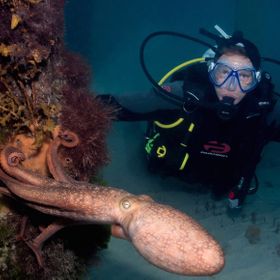
pthirschfield
FollowThis gorgeous male weedy sea dragon from Melbourne, Australia is carrying a tail full of bright pink eggs!
This gorgeous male weedy sea dragon from Melbourne, Australia is carrying a tail full of bright pink eggs!
Read less
Read less
Views
185
Likes
Awards
Awesome
Peer Award
Superb Composition
Absolute Masterpiece
Top Choice
Magnificent Capture
Outstanding Creativity
All Star
Genius
Superior Skill
Top Ranks
Categories
Same photographer See allBehind The Lens
Discover more photos See all
Behind The Lens
Location
This male weedy sea dragon carrying a tail full of bright pink eggs was photographed under Flinders Pier in Melbourne Victoria.Time
Mid-morning with plenty of sunshine and coming up to high tide is the perfect time to capture amazing images of weedy sea dragons as they float near the bottom of the wooden pylons across the shelly, sandy bottom beneath the pier.Lighting
Underwater photography is all about balancing natural sunlight with strobe light. The challenge is not to light sediment in the water between the strobe and the subject, and to bring out the full vibrance of the subject's colours using the strobe.Equipment
This image was captured using a Canon G12, Recsea underwater housing and a single YS110 strobe. ISO 100, f5.6, 1/125Inspiration
Weedy sea dragons are often quite shy and most images of them tend to be side-on with the tail extended in line with the rest of the body. It took weeks of pre visualising the image, tremendous patience, precise timing and a fair bit of good luck to photograph the sea dragon on this angle, turning towards the camera with the eggs on full vertical display, looking a bit like a pink corn cob. Put simply, it was an angle I hadn't seen accomplished by anyone else before and one that I was thrilled to successfully capture.Editing
This image was processed in Lightroom, using spot correction to remove any water sediment or backscatter resulting from strobe use. I sharpened the outline of the image using the clarity brush to make it pop against the background and boosted both blacks and whites to help make the image feel more three dimensional.In my camera bag
As an underwater photographer, my kit consists of a primary camera body plus a spare body which may be needed in the event of the camera flooding underwater. I dive with a Recsea camera housing coupled with tray, handles and arms onto which a video light and a strobe are mounted. Choosing to dive with a compact camera with full manual capabilities means that I can switch between stills and videos, macro and wide angle within the same dive, but the addition of a +10 Subsea flip down diopter makes the transition to macro more manageable, without the limitation of having to preselect a lens prior to getting in the water which can result in lost opportunities, depending on which critters decide to show up.Feedback
Different species of marine animals have sets of behaviours that can be predicted, and individual animals have unique personalities. When you are looking to capture a top quality image of a marine animal, research as much as you can about the species, then spend plenty of time observing the animal you have chosen as your subject. Previsualisation and patience are powerful keys. I have sometimes spent many months trying to capture a particular image with many failed or near-miss attempts along the way. When photographing critters underwater, it is as important to control your energy and to remain as zen like as possible so as not to disturb your chosen subject as it is to be one with your camera. And definitely master the art of strobe positioning to ensure that your colours pop without lighting sediment in the water.













































